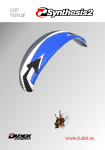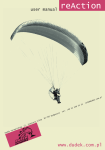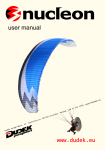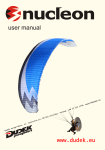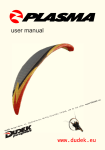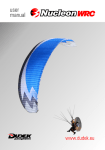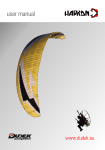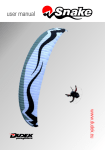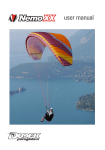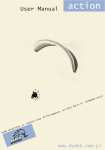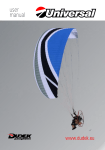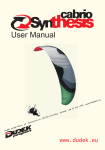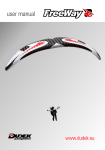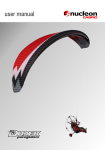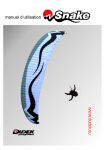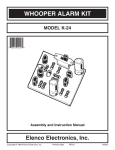Download User Manual
Transcript
User Manual ek Dud ul. s, der i l ag Par ko, els Osi 1 3 0 86U, a 2 n l tra Cen 52 +48 d, n a Pol 0, 174 324 eu ek. dud @ t or exp www.dudek.eu NOTE! Please read this manual before your first flight TABLE OF CONTENTS Page 1. Introduction......................................................................................3 2. The wing..............................................................................................4 2.1 Design 2.2 Construction 3. Flight operation............................................................................8 3.1 Steering lines and speed system adjustment 3.2 Free flying 3.2.1 Take-offt 3.2.2 Flight 3.2.3 Landing 3.2.4 Winching 3.3 Powered flight 3.3.1 Take-off 3.3.2 Level flight 3.3.3 Landing 3.3.4 Golden rules 3.4 Quick descent methods 3.4.1 Big ears 3.4.2 Spiral dive 3.4.3 B-stall 3.5 Acro Flying 3.5.1 Wing over 3.6 Extreme manoeuvrese 3.6.1 One sided collapse 3.6.2 Frontal collapse 3.6.3 Full stall and negative spin 3.6.4 Parachutal stall 3.6.5 Line over and cravatte 3.6.6 Emergency steering 4. Canopy care........................................................................................25 4.1 4.2 4.3 4.4 5. 6. 7. 8. 9. Storage Cleaning Repair Deterioration - a few tips Technical data.................................................................................27 Warranty, AeroCasco..............................................................28 What have you bought......................................................................30 Rigging tables.....................................................................32 Risers........................................................................................37 Leading edge Trailing edge Cell Cell openings Stabilizer Steering line Brake pulley Main suspension lines Trim tab Risers USER MANUAL 1. INTRODUCTION CONGRATULATIONS! We are pleased to welcome you among the growing number of Dudek Paragliders pilots. You've become a proud owner of state-of-the-art Synthesis paraglider. Extensive development, application of the most modern methods and thorough testing make the Synthesis a userfriendly paraglider, offering the pilot a lot of fun combined with great performance. We wish you many enjoyable and safe flying hours. DISCLAIMER Please read this Manual carefully and note the following details: $ $ $ $ $ The purpose of this Manual is to offer guidelines to the pilot using the Dudek Synthesis wing and it is by no means intended to be used as a training manual for this or any other paraglider in general. You may only fly a paraglider when qualified to do so or when undergoing training at an accredited School or with an Instructor. Pilots are personally responsible for their own safety and their paraglider's airworthiness. The use of this paraglider is solely at the user's own risk! The manufacturer and distributor do not accept any liability connected with this activity. This paraglider on delivery meets all the requirements of the EN 926-1 and 926-2 regulations. Any alterations to the paraglider will render its certification invalid. NOTICE Dudek Paragliders warns that due to the constant process of development the actual paraglider may differ slightly from the one described in the manual. 3 2. THE WING WHO SHOULD FLY Synthesis? Whether you have already tried paramotoring or you’re only learning it – you know it is your game. You are excited with the possibility of taking off almost anywhere. You need a wing that is both agile and easy to control, that will allow you to discover freedom of three-dimensioned journey – there is an endless number of distant and beautiful spots to visit from the air. Mostly you will be just enjoying your time, but if you one day would like to try yourself out in a competition, you wouldn’t like your wing to confine you. So your paraglider has to be versatile, relatively slow and easy at take off (running around with 40+ kg on your back is not necessarily your ideal of pleasure). Yet it has to be equipped with a set of trimmers allowing it a wide speed range, with possibly high top speed. Of course you would like it to be safe and stable too, both in thermals and in chance turbulences, including top speed configuration (full trim +speedbar). Synthesis does fulfill all of these seemingly contradicting requirements. It is simply a synthesis of desired powered-wing features with gentle characteristics of free-flying paragliders. 2.1 DESIGN After a long success story of our Action and ReAction paragliders we’ve set us another ambitious goal: to create a PPG wing that could be flown by pilots of all skill levels, combining great reflex-wing performance with freeflying paragliders ease of take-off. We succeeded and in the Synthesis our dream came true. While designing it we put a lot of effort into flight safety, pleasant handling, good performance and wide speed range, so that it will satisfy a great many pilots. In many prototypes leading to final Synthesis version we have tested several airfoils based on our own Dudek Reflex Airfoil. Often we tried to decrease its stability in order to achieve take-off and handling, but invariably we ended with worsened safety at full speed with little improvement elsewhere. After several prototypes our efforts paid up and we arrived at a wing with great maximal speed (61 km/h), wide speed range on trim (37 to 49 km/h) and as easy a start as possible with reflex profile. Main feature of reflex airfoil paragliders, i.e. passive safety, remained intact. We feel safe to declare the Synthesis to be the best wing available in its class. The fundamental feature of a good PPG wing is its great stability and tuckresistance. A good PPG wing must be a very stable and tuck-resistant craft. 4 USER MANUAL When this is achieved, the user does not have to concentrate all the time on piloting, thus saving energy for navigation, taking pictures or simply enjoying the flight. In addition the faster and safer your paraglider is, the more often you can fly. While the Synthesis was designed to retain all the features of a conventional paralider, the application of a reflex aerofoil section added several new qualities. First of all, using that profile means that the wing stability does not depend exclusively on the pilot's weight and actions. It maintains its own pitch attitude, rising and falling through thermals while remaining stable above your head, without need for so much pilot input. Generally speaking the reflex profile is a special kind of aerofoil section. The specific static pressure distribution creates a situation where at low attack angles, only the wing fore part (some 60% of the chord) is producing lift, while the rear 40% of the chord creates an effective stabiliser against excessive decrease of the attack angle. The trimmer system allows you to considerably raise the rear part of the airfoil, thus effectively reducing projected chord and surface area by some 30%, giving the paraglider a higher wing loading and increased speed without change in the angle of attack. The centre of pressure also moves forward, adding enhanced pitch stability. Such a shift of loading gives the wing exceptional tuck-resistance and increases projected aspect ratio, resulting in much better flight data, especially at full speed. Should you require more lift at lower speeds, the rear section can be pulled down to restore a full airfoil, effective along the whole chord. Piloting the Synthesis actually reminds one more of flying a conventional powered aircraft than a paraglider. Below we will try to give you a closer look at some of the remarkable Synthesis features. 2.2 DESIGN The Synthesis 3D body was designed in our CSG (Canopy Shape Guard) system, comprising many elements resulting in exceptional coherence and stability of the shape. Below you will find a short description of CSG subsystems. The Synthesis has an elliptical planform with slightly rearward swept tips. Every second cell is divided in two, with ribs additionally supported by diagonal VSS (V-shaped supports) system. Such arrangement ensures a smooth top surface, exact aerofoil reproduction across the entire wingspan and yet more importantly, minimal number of suspension points. 5 The lower surface has a RSS (Reinforcing Strap System) applied in the wing’s interior. RSS is an ballooning-independent reinforcements system made entirely of paragliding fabric, effectively stiffening and stabilizing the canopy. Synthesis’ aerofoil is another product of our Dudek Reflex Airfoil technology. It was calculated with our previous experiences in mind and thoroughly tested with numerical methods The suspension points areas are additionally reinforced with laminated fabric so that loads are equally distributed on three planes: vertically (with the ribs), diagonally (with VSS system) and level through RSS. All crossports have been prepared using OCD (Optimised Crossports Design) technology. Carefully designed shapes of the openings and their optimal placement between stress lines guarantee efficient pressure distribution in the canopy and its quick inflation. These openings are scaled together with the ribs, so that their replicability is flawless and they do not disturb the aerofoil in any way. The Synthesis’ leading edge is closed to airflow, and its precise shape is supported by reinforcements of laminated fabric. Cell openings are positioned on the undersurface in the vicinity of leading edge. Their position was chosen very carefully, so that they got maximum ram effect in possibly many flight situations. In several places the leading edge features our CCS (Closed Cell Structure) system – this is a number of closed cells in most important locations. It’s goal is to hinder the backflow form the cells out and thus to facilitate their refilling and canopy recovery in case of a collapse. Each wingtip consists of four additional cells creating stabilizers. They maintain correct tension of the canopy, improve directional stability and play important role in keeping your turns efficient and even. In the very tips there are cleaning slots, placed there for easy removal of dirt form inside the wing. Careful selection of modern fabrics and design solutions brings about great strength and durability of the Synthesis. All materials used come from marked production batches, and each production step can be verified down to identification of specific worker and controller. Fabric Each kind fabric has it unique features and characteristics. We composed them so that their interplay creates a perfect blend. The Synthesis’ upper surface is made of Porcher Skytex 45 Evolution fabric (formerly named Aquatic), perfectly proven in our earlier wings. Basically it's a nylon material covered with superb E85A impregnate, introduced into mass production in January 2002 after a series of extensive laboratory and 6 USER MANUAL real flying tests. Such covered fabric is not very stiff and - what's most important - has increased tear, stretch and UV resistance. It is not siliconed, so minor repairs can be easily made with self-adhesive strips. The lower surface is made of Skytex 40 Classic with E38A impregnate. This fabric has a great weight/resistance ratio and is one of the greatest Porcher successes in providing proper materials for the paragliding industry. The ribs must be as rigid and stretch-resistant as possible. We found these qualities in Skytex 40 Hard with E29A impregnate. All reinforcements are made of SR-Scrim. Rigging system All of the Synthesis suspension lines are sheathed by a coloured polyester layer which is covering brownish Technora core. Low number of lines required such composition, featuring high strength and stretch-resistance. The rigging system consists of individual lines looped and stitched at each end. The main lines are made of Technora and depending on their location. have 1.8 mm, 1.5 mm, 1.3 mm or 1.2 mm diameters. Such diversity stems from different loads on the line groups concerned. Lines of the middle and upper layers are made of 1.2 or 1.3 mm Technora. The upper level lines (gallery) start at the attachment points. Every two lines join one middle layer line. These in turn connect by twos or threes to the main suspension lines, which are attached to the risers with triangular quick links (maillons). To prevent their slipping off, the lines are kept together with a rubber 'O ring'. All the maillons are made of corrosion resistant, polished stainless steel, ensuring excellent strength and durability. Brake lines run from the trailing edge through consecutive cascades to the main steering lines, which are lead through pulleys connected to the rear risers and then fixed to the brake handles. Steering lines do not carry any load until the brakes are applied. Some of the steering lines (of the FC group) are additionally led through rings sewn into the trailing edge. Because of this feature the trailing edge is shortened on application of the brake, so that steering becomes lighter and more effective. All the lines are distinguished with colours depending on their strength and diameter as follows: 2,3 mm; strength: 420 daN; colour: celadon (willow green), 1,8 mm; strength: 280 daN; colour: red and orange (the latter for pulling big ears), 1,5 mm; strength: 190 daN; colour: violet, 1,3 mm; strength: 140 daN; colour: green, 1,2 mm; strength: 90 daN; colour: blue. (given colours are subject to slight changes). 7 The risers For the Synthesis we have chosen four-way risers equipped with: $ ELR (Easy Launch Riser) system. This is an specially marked A rises (gold ribbon) $ speed-system affecting A, B and C risers when engaged;, $ trimmers of red band with visible scale (red – slow and blue – fast trim setting), designed for quick and easy replacement in case of deterioration; $ two levels of the pulleys, to be used depending on the hangpoint $ Tip Steering Toggle system (see details on pages 10). For quick and easy recognition in emergency, some of the risers are distinguished with coloured band as follows: A - gold (used for launching) A' - blue (used for big ears) B - red (used for B-stall) D - grey (needed to keep the glider down in strong winds or interrupting the launch). Main A row suspension lines connect to an A riser (gold) and A' (blue). B and stabiliser lines go to B riser (red), C lines (black) go to C riser, and D lines to D riser (grey), which through pulleys keep the steering lines too. Brake handles are attached to the steering lines at optimal places, guaranteeing safe and effective operation. On the main brake lines there are two points marked, higher and lower, to be used depending on the harness hangpoint. On adjusting the steering lines see chapter 3.1. Our newest brake handle used in Synthesis besides its robust yet light design features: 8 $ DCT (Double Comfort Toggle) system, $ EK (Easy Keeper) system - look below USER MANUAL 3. FLIGHT OPERATION 3.1 STEERING LINES AND SPEED SYSTEM ADJUSTMENT We strongly advise following actions to be supported by an instructor or at least an experienced pilot. A brand-new Synthesis has its steering lines positioned for powered flight in high hangpoint configuration. The risers of the Synthesis are shorter than in most paragliders, so the differences in hangpoints present somewhat smaller problem. Still, there are two sets of pulleys prepared, higher and lower (see risers scheme on page 37). Also on the main steering lines there are two spots marked for brake handles to be accordingly fixed. When flying with lower hangpoints (or free-flying) the brake lines are to be run through the higher pulleys only, and the brake handles should be positioned at higher marks, thus shortening the brakes in general. The rule is simple - higher hangpoints require longer brake lines, lower hangpoints require shorter lines. Before you take your Synthesis on powered flight, we strongly advise to try out everything first. Hang up the entire PPG unit with ropes, sit in the harness and have someone pull up the risers. You must make sure that in flight you will always be able to reach the brake handles, even if the airflow blows them away. While being suspended in this way, you have a perfect opportunity to adjust the speed system too. The speedbar should not be pulling pull its lines (and risers) when it is not applied. Neither should it be too loose, for it could catch the propeller then. An additional way to check the whole configuration out is to visit take-off site in steady winds. With the engine off, fill the wing and take it up over your head. When it stabilises, check that the brakes are loose and are not pulling the trailing edge. There should be a spare inch or so before they activate. Remember that it is always safer to set the margin of play too big than too small. And, most important, the setting must always be symmetrical. 3.2 FREE FLIGHT (no power unit) Although the Synthesis according to its design book is a fast PPG wing, it behaves surprisingly well as a classic paraglider too and can be used as such without any changes. The essential difference between Synthesis and classic paragliders means is due to its increased tuck-resistance (both during start and flight) and greater 9 The bar itself is very durable – it is going to serve you long. 10 y 5 7 9 1 e c c N c ,0 ,0 ,0 ,0 ,4 ,1 ,8 ,6 ic 0 0 0 0 5 7 9 1 1 3 4 6 o ,2 1 ,1 ,5 ,7 1 2 2 ,0 o ,0 ,3 ,7 0 y ,1 y ,7 ę r in ę r in 3 4 5 5 a 7 8 9 0 ,3 ,7 ,0 ,2 a 0 2 5 7 4 2 0 6 łu 2 5 8 0 r z z z z z 1 6 0 d 0 d 8 9 1 1 t C d d ,9 ,6 ,0 ,0 g ,2 ,6 ,0 ,4 t e e p y b 0 0 0 0 6 7 9 1 9 3 6 7 3 = 5 2 0 0 a 0 0 h łu łu ię f a 1 5 0 0 ó 3 2 0 4 5 2 0 5 5 0 e ik u u ż ż je je je c ś s t t ,2 ś e o e ć n ; z t ś ś li l tr ć ć o p n o n g p y o m c e w w w ię a s ię k r r r r d = ę = c c z o z u o 7 a ło ło c ia ,4 a a ś ie ż e n iu /s ,2 k ; m iu ] m m ] [ n & m ] a = 1 ] m c [ i ,3 ,5 2 3 m y & 6 n a x = ,8 k m /m ś ] 1 [ g x o ls m /h a 0 o iu ] ] ; i P 8 m n ] [ 1 ,5 , e m [ [ m n 2 9 m 1 z ż m a [ m c /m ie te c e 4 c k [ - a [ ż [ & z ło g c a m e - ie w ] z s u 5 /m in n c ,3 o o z g 4 g /m z 1 li n u 3 t 1 g r r m k p iw g iw z a [ o z d n 0 a ć & w w t y o 4 0 L ś a ti 4 B m o e w w ia ia ic R c ,2 n lu d y s n r S ie ie tr a t 1 o ś a ] h h łu r N la a , v : n z o ć is ; g c c a d a o s a E C H e s ć O n t 3 k r z z a im t 5 ż u o 1 o 2 ś a [ r r r s x x x o M y 3 ię k k k k k łu r o in c n e e e n a i ie ie 2 1 A = p e z ,2 ,4 ,0 ,0 n m T T T S h k g s z jd jk S w w n c 2 8 4 9 ą 1 2 4 5 - - - a 0 0 5 0 1 a ,2 in c e a y y y ś k a A o o k k k R S 2 2 2 3 C O O E O L 5 5 5 5 2 2 2 3 2 2 2 2 R 1 1 1 1 R 9 9 9 1 W 5 W 3 P m P m N 2 2 2 3 N 6 6 6 6 D 7 7 7 8 Ł 4 4 4 4 M 7 8 9 1 W --7 -L T T T P P 2]P 2]S 2S 2S 2S 2 Tip Steering Toggles (TST) handle TST TDS In order to facilitate steering the wing while at maximum speed configuration (opened trimmers and full speed-bar) we've invented our own novel system of controlling the stabilizers. Prior to grabbing miniature TST-handles (Tip Steering Toggles) pilot places the main steering handles in a special Toggle Docking Stations, equipped with strong neodymium magnets. In this way you can comfortably steer the wing via TST handles, not worrying about the brakes getting tangled. Easy Catch bar The Easy Catch Bar is a medicine for all those having troubles with finding bar inflight. It is designed so that the bar always remains forward of the lines. USER MANUAL Double Comfort Toggle (DCT) DCT: in order to satisfy different needs of our clients we have created a Double Comfort Toggle system. With this solution it is possible to have your brake handles in stiff or soft configuration, with no need to buy another set of toggles and replace them every time. All you have to do now is take out the stiffening rod and there you are - the soft handle is ready to use. Easy Keeper (EK) Easy Keeper is the name of our new indigenous way to hold the brake handles at the risers. The strong neodymium magnets keep them firmly in place, while both attaching and releasing goes smoothly and easily. This idea was developed especially for the PPG dedicated paragliders, for there is often a need to take your hands off the brakes to check or fix things. With Easy keeper you can easily secure the brakes in flight, thus minimizing danger of their contact with the propeller. 11 speed range it can be safely flown in strong conditions. Generally (and paradoxically from traditional point of view) the faster you fly, the safer is your flight. 3.2.1 TAKE-OFF In case of classic launch we recommend that after laying out the wing all lines be taut, without unnecessary play. The Synthesis is pulled up with A risers only. The optimal trim setting is “0” (when launching for powered flight) or fully closed (when launching free-flight). Applying steady pressure on the A risers move forward. The wing practically does not overshoot, so the front collapses that otherwise happen quite often at launch, with the Synthesis occur rarely. Instead it kind of waits for you to catch up with it. In case of reverse launch we also recommend abovementioned trim settings. Due to lack of overshooting take-off is easy, pilot has only to brake slightly. Reverse launches can be executed without any problems even in weak wind (1,5 m/s). Caution! During take-off it is important to keep the risers under pressure until almost airborne. Reflex profile used has an inherent tendency to increase the angle of attack. In effect, Synthesis can lag behind the pilot when not pulled up appropriately. 3.2.2 FLIGHT The increased speed range of Synthesis may demand some attention. Nevertheless, once you have mastered these additional aspects, flying will become pure pleasure. Good handling will let you make the best use of thermals, and increased speed on glides means that your presence in sinking air will be shorter. To avoid stalls when braking with slow trims setting (red area), their movement is restricted by the tape sewing. (Note: it is possible to push the sewn tape through the buckle with both hands to replace it, but normal operation range is restricted by said place. When the trims are fully opened (blue area) the wing becomes faster and stiffer, increasing its stability even more. The brake forces increase too, as well as the distance to the stall point. The radius and bank angle in turns grow proportionately to the growing brake forces. If the trims are set fast (or fully opened) and the wing is not flown near the ground, a switch to TST steering is advised (see page 10). TST system can be used in all speed system & trim configuration. 12 USER MANUAL Speed system use Full application of the speed system increases flight speed by some 30%. In contrast to most paragliders it does not decrease wing stability, in fact Synthesis seems to counter the turbulence even better then. Still, if you encounter serious trouble, it is advisable to release speedbar. With application of the speed system the brake forces increase considerably, and brake effectiveness decreases. At maximum speed and fully opened trims we strongly recommend steering the wing with TST system. Turns executed in this way will be slightly wider, but strength needed to initiate turn will be smaller and there will be no decrease in speed. The speed system can be safely used at all trimmer settings. 3.2.3 LANDING With closed trimmers (red area) Synthesis lands like any other paraglider. The brake forces, initially low, are growing proportionally, giving ample warning before stalling. Still you should be careful when flying at low speeds until fully familiar with brake operation. When landing with trims set fast (blue area) may require proportionately more space, as the paraglider has a lot of kinetic energy and careless application of brakes may even cause the wing to climb. Most pilots get to know the wing relatively fast and quickly gain enough trust to fly it in stronger conditions than they did ever before. Still, you should always be careful when flying low. Remember that Synthesis flies faster than ordinary paragliders and sometimes it can be of importance (e.g. when landing on a slope). After landing in strong wind the paraglider can be safely put down with B risers, or with a strong pull on the rear D risers. 3.2.4 WINCHING Synthesis is not designed for winching. As mentioned before, reflex profile used in the wing has an inherent tendency to increase the angle of attack. While in normal flight such a disposition makes it safer, during winch start it can be dangerous. Nevertheless, a lot of successful winches on Synthesis have been made. Experience shows that it should only be done with opened trims (blue area). To sum it up: winching can be done, but proper attention must be paid. 13 3.3 POWERED FLIGHT CAUTION: Before each start it is necessary to have a thorough check of the wing, harness and power unit. In powered flight most of the wing characteristics remain as described above (chapter 3.2). Still there is additional information needed, concerning power output, proper matching of the wing/engine/propeller etc. Dudek Paragliders cannot take responsibility for all possible combinations, but if you contact us we are always ready to help. First flights In order to get familiar with your wing we recommend flying with closed trimmers at first (read area), because in this configuration Synthesis behaves asa standard wing. Flying like that try pulling the brakes some until you feel resistance, usually it will be at about 1/4 of the range. Once you feel competent with your wing, you can start experimenting with faster trim settings and speed system. Learn to use all the additional speed and safety of the Synthesis. 3.3.1 TAKE OFF Classic launch with no wind Even when it seems that there is no wind at all, it is rarely so. Therefore always be careful in determining the conditions, as because in PPG flying it is most important that the launch and initial climb are performed with a head wind (the danger of losing your airspeed while crossing the wind gradient is greatly reduced). Special attention must be paid to trees, power lines and other obstacles, including the possibility of emerging rotors. Wing preparation Lay out the paraglider downwind of the power unit, with all suspension lines taut and pointing toward center of the power unit. The risers are to be laid on the ground. Set the trimmers at “0” (see fig. 2). In strong conditions faster settings (blue area) can be advised. Make sure that you warm up the engine while standing windward of the wing. Stop the engine before clipping in the risers. Now have a quick check if: $ the helmet is on and locked, $ the risers are clipped in the carabiners, $ the trimmers are set, $ nothing will get in propeller's way, $ speed system is running without problems, 14 USER MANUAL $ $ $ steering lines and handles are free and not twisted, engine delivering full power, airspace is clear for take off. When you are sure everything is OK, you can clip in the wing and execute launch as described in paragraph 3.2.1.a. From now on you should steer the paraglider facing forward, without looking back over your shoulder (when the wing is low behind you, turning can cause some lines to get in the propeller). Also, possibly falling on your back and the propeller is dangerous (and costly!) so this should be avoided at any price, even that of some damaged lines! During launch, when you feel that the strain on both risers is equal, open up full power and lean back to counter the engine thrust, so that it can push you forward rather than to the ground. The best option is not to use the brakes, allowing the paraglider to rise as it was laid out. If it starts to swerve from its course, just pull the opposite riser and run under the centre of the wing while preserving starting direction. If the wind suddenly weakens, give a stronger pull on the risers. If the paraglider drops to one side or back too far to be lifted again, kill the engine, interrupt launch and check the conditions once again. As the wing rises, the forces grow lighter and it should stabilise above your head without overshooting. This is the best moment to check if it is inflated well and the lines are not tangled, but do it without stopping nor turning. If you feel the forces on the risers decrease, run faster and let go of the risers. See whether there is any opposition on the brakes and, if necessary, use them to correct direction or to increase lift at take-off. Remember: $ If the cage of your power unit is not stiff enough, the risers strained during launch can deform it to the extent of collision with the propeller. Before giving it full power, check that the cage does not catch any lines. $ Any brake operation (or steering inputs in general) should be smooth and gentle $ Do not try to take off until you have your wing overhead. Hitting power before that can cause dangerous oscillations $ Do not sit in the harness until you are sure you are flying! $ The faster the trim setting is, the more brake input is required to take off $ The lower the hangpoints of your power unit are, the easier is the launch. 15 Reverse launch in strong wind Reverse launch can be executed holding in one hand both A risers and one brake, throttle and the second brake in the other hand. With a decent wind it is by far the best way. In weaker wind it is better to prepare a classic launch, as running backwards with an engine on your back is not an easy thing to do. It is reasonable not to pull the wing up until you are really determined to launch, especially when it is clipped in. Lay down the rolled paraglider with the trailing edge facing the wind. Unfold the wing enough to find the risers and check that no lines are looped over the leading edge. Stretch the risers against the wind, separating the left and right one. We suggest that you lay the risers in the same way as you will be turning during a reverse launch, and place one riser over the other, with the rear risers upmost. It should be done this way because once you clip in, the cage of your power unit will make turning on your own impossible. Now run the pre-launch checklist. After warming up the engine put the power unit on, turn to face the wing, go to the risers and clip them in the appropriate carabiners. Pulling on the front and rear risers open the cells. It is a good idea to pull up the wing briefly in order to check that the lines are not tangled. Holding the risers, brakes and throttle as described above, pull the front risers and raise the paraglider over your head. On most occasions you will not have to brake it, especially if the trimmers are set for fast flight (blue area). Perhaps it does not agree with our experience, but this is the way the reflex profile works. When the trimmers are opened (set above “0”), the Synthesis profile stabilises the wing and does not allow it to surge forward. It can even stay back a little - in such case pull the brakes a little and the glider will come forward. Once you have it overhead, turn around, open the throttle and take off. As with the classic launch, in this case too you have to find such combination of trimmers, brakes and throttle settings that will give you the best speed and rate of climb. Remember: $ You are launching with your hands crossed. You have to really master this technique before trying it with a running engine on your back $ Any brake operation (or steering inputs in general) should be smooth and gentle $ Do not try to take off until you have your wing overhead. Hitting the gas pedal before that can cause dangerous oscillations $ Do not sit in the harness until you are sure you are flying! $ The faster the trim setting is, the more brake input is required to take off 16 USER MANUAL When clipping in the crossed risers, you can find proper connection of the speed system particularly hard. Be careful not to confuse the risers! Climbing Once you took off safely, continue heading against the wind, using brakes to correct rate of climb. Do not try to climb too steeply - attempts to increase climb rate by pulling the brakes will have an adverse effect - due to the additional drag actual rate of climb will worsen, and with the throttle fully open even a stall can happen. In powered flight the Synthesis behaves more like an aeroplane than a paraglider, and it is good idea to think about it in this way. If there are no obstacles present, it is by far safer (and more impressive for the spectators) to fly level for a while after take-off and gain some speed before converting it to height with a brief pull on the brakes. Another reason not to try climbing too steeply is the risk connected with engine failure at low altitude. Although the Synthesis in a steep climb does not stay back so much as conventional paragliders do, the low speed is more likely to cause a stall. Besides, you should always be able to land safely in case of engine malfunction, so it’s better not to take unnecessary chances, and better to fly with a safe margin of speed. Depending on the power unit geometry, it is possible that after take-off you will notice a propeller torque (turning moment). It will try to turn you around, so be prepared for counter-steering with a brake or harness cross-bracing. If it happens during steep climb on slow trim and full power, beware of the stall possibility. Due to typical PPG feature - considerable vertical distance between thrust axis and wing chord - the range of safe power operation is closely connected to your skills and equipment. Power-unit induced oscillations Certain configurations of engine weight, output and propeller diameter can cause serious oscillations, during which the pilot is lifted to one side by the torque effect, swings down due to his weight, then is lifted again and so on. To avoid this you can: $ change the throttle setting and/or $ adjust the cross bracing to counteract the torque, if there is one $ present and/or $ shift yourself to the other side of the harness and/or $ change the trimmer setting. The best method is to fasten opposite cross-bracing, or apply some weight- 17 shift. Such oscillations usually occur at full power - the greater the engine output and propeller diameter, the bigger the swings. In addition there are often too late or wrong pilot reactions, increasing the trouble instead of solving it. In any case the safest way to deal with this question is to close the throttle and release the brakes. Especially less-experienced pilots tend to overreact. It is called a pilot-induced oscillation, and proven solution is to leave the brakes alone. 3.3.2 LEVEL FLIGHT Once you have gained safe height after take-off and wish to go for a route, you can turn onto the right direction, fully open the trimmers and let off the brakes. If the conditions are turbulent it can look foolhardy, but this is the essential feature of the reflex profile - the faster you fly, the safer your Synthesis is. That's why you really can confidently release the brakes and enjoy your flight. CAUTION: Some pilots with previous free-flying experience may have a well-grounded habit of keeping the brakes slightly applied at all times. Such a technique, while quite reasonable on a free-flying wings as it allows for quick pilot reactions and decreases sink, is not advisable on reflex-profile wings. When you pull the brakes, the Synthesis profile loses its self-stabilizing features. If you happen to have a variometer or altimeter aboard – watch it. In level flight it is very easy to start climbing unintentionally. The instruments will help you optimise speed and fuel economy. Of course each flight will depend on current configuration of your gear, but thanks to its ability to fly safely without constant piloting the Synthesis will let you adjust everything to the best effect. Good knowledge of weather conditions (e.g. wind at different altitudes) and intelligent use of thermals, convergence and other kinds of lift will help you greatly reduce fuel consumption and increase flight range. Of course the engine is always there to bring you in the right place. Do not hesitate to lead the Synthesis into tight thermalling then, and you will be surprised how efficient it is. Possible shortening of the trimmers will make the climb ratio even better. Trimmers and speed-system operation The reflex wing section enables the Synthesis pilot to use a wide range of trimmers and speed-system action. You are free to experiment with all possible settings, as long as you are on safe altitude. Fully opened trimmers (blue area) increase the speed and stability of the 18 USER MANUAL wing, and with it also its ability to cope with turbulences and overall penetration. As forces on the brakes grow at high speeds, the weightshifting or steering with TST system becomes increasingly effective. Turns executed in this way are slightly wider, but needed steering force will be smaller and airspeed will not decrease. With slow trimmer settings (red area) there is an improvement in sink and steering forces diminish, so exploring the thermals becomes possible. Worth noting is the Synthesis impressive speed range - the maximum speed is almost three times greater than stall speed. Study drawings of trimmers and speed-system setting, as well as their influence on the wing shape. Independent of the current wing configuration and speed, turns can be much tightened and more effective with differential brake operation. Slight use of the outer brake (with considerable amount of the inner one) will diminish the loss of lift during turn. Turns can be much improved by additional use of throttle, speed-system etc. as well. Once with growing experience you will master these techniques, you will be able to execute fully coordinated and effective turns, that will bring to mind the aeroplane handling. Remember: $ Trimmer setting is another part of the pre-start check list! $ If it will be asymmetric, the wing will be turning all the time. And if you will inadvertently set them off, the reflex profile of the Synthesis will keep the wing level, so after opening the throttle you'll start to descend with increased speed instead of climbing. 3.3.3 LANDING In PPG flying there are two kinds of landing: with and without power. Power off landing At an altitude of 50 metres switch the engine off and start gliding as on a conventional paraglider. It reduces the chances of damaging the propeller on landing, but on the other hand there is only one attempt possible - so it has to be done right! With or without power Synthesis better copes with turbulence on open trimmers (blue area). So, if the conditions are rough, it is better to make an approach with greater speed, plan a lot of space (as for a hangglider) and wear that speed off before touching down. Synthesis preserves the energy well, so there is a long float necessary to exchange the abundant speed for lift. 19 If the landing field is not big enough and you have to land on the spot, we advise you to set the trimmers in red area. It will increase lift coefficient of the wing, simultaneously decreasing its sink rate and speed. Such an action is especially important when flying with high surface loading. Landing with power on Make a flat approach with the engine idling, then level out and lose the speed before final flare. Immediately after touchdown switch off the engine. The main advantage of this procedure is of course the possibility of a repeated approach in case of any misjudgement. Still, if you forget to switch off the ignition before the wing falls down, there is a considerable risk of damaging propeller, catching lines in it or even suffering injuries connected with falling on your running engine. Remember: $ If possible, get to know your landing area before take-off. $ Whenever possible, get to know the landing field before taking off. $ Check the wind direction before planning the approach. $ Landing with power off requires much less space. $ In case of any doubt, practice the landing until you feel totally safe. 3.3.4 GOLDEN RULES! 20 $ Never place the power unit downwind of the paraglider. $ Check, double check and then check once again if there is no fuel leakage. $ Do you have enough fuel for the flight? It is always better to have too much than too little! $ Check if there is nothing loose in the harness, that could possibly contact the propeller in flight $ Whenever you encounter a problem, fix it AT ONCE however small! $ Always put on and lock the helmet before getting in the harness $ Before each launch run a full pre-flight inspection $ After landing, control the wing facing the direction of flight, as on turning you always risk getting lines in the propeller. Turn only if there is danger of falling on your back $ Do not ask for trouble - do not fly over water, between trees or power lines and other places where engine failure will leave you helpless USER MANUAL 3.4 $ Remember turbulence caused by other gliders or even yourself, especially when flying low $ It is not reasonable to let go of the brakes below 100 meters, because a possible power unit malfunction may require immediate attention $ In general never trust your engine, as it can stop at any moment. $ Always fly as if that’s exactly what it's going to do $ Unless it is not absolutely necessary (e.g. collision avoidance), do not USER MANUAL execute tight turns against the torque direction. Especially when climbing you can easily enter a stall and consequent negative spin $ Do not fly at low altitude with a tail wind, as it pretty much narrows your options ! $ Do not wait for the problem to grow - any change of engine sound or a vibration can indicate some trouble, or even serious trouble. You'll never know until you land and check it out $ Be certain of your navigation $ Remember that not everyone is fond of your engine noise. Do not scare the animals. QUICK HEIGHT LOSS 3.4.1 BIG EARS In order to get the big ears you have to pull down the outer lines of the A' risers (usually distinguished with blue colour) by about 50 cm. While inducing big ears you should never never let the brakes out of your hands. After tucking the tips in, Synthesis will continue to fly straight with increased sink rate (up to 5 m/s). You can steer the wing pretty efficiently with weightshifting. After releasing the lines, the paraglider will usually open up on its own or you can assist it with a long stroke of the brakes. For the sake of safety (the possibility of a parachutal stall) it is reasonable to engage speed system after pulling big ears in order to lessen the angle of attack of the wing centre. Executing big ears with open trimmers is very difficult due to the reflex profile stabilisation. CAUTION! See the PARACHUTAL STALL chapter. Never try to pull big ears during powered climb, as the increased drag 21 can lead to increase of the angle of attack and a parachutal stall. Besides, pulling the ears while climbing is pointless anyway. 3.4.2 SPIRAL DIVE A spiral is characterised by reaching the highest sink rates possible. Significant G-forces, however, make it difficult to sustain a spiral dive for long, as it can place high loads on both pilot and glider. Never do this manoeuvre in turbulence or at too high bank angles. Control the dive and do not exceed 16 m/s sink. If the dive is not stopping after releasing the brake, assist the glider with the outer one. NEVER DO BIG EARS IN A SPIRAL! In this manoeuvre smaller number of lines is carrying an excessive load mulitplied by the centrifugal force, what can lead to damage of the lines or even the paraglider itself (load of a single line can be much higher than passed in certification trials (i.e. 8 G). 3.4.3 B-STALL To enter a B-stall, simultaneously pull down both B-risers (red tape) by 10 – 15 cm. The wing will collapse across the entire span along its B-row, the airflow over top surface will break and canopy surface will be decreased. Forward movement will be almost completely stopped. Further pulling B-risers is not advised, as it increases wing instability. If the canopy forms a horseshoe with both wingtips in front of the pilot, gently apply both brakes to recover. To exit a B-stall, the risers should be released in a smooth and decisive manner. On quick and symmetrical releasing B-lines the airflow will reinstate and the wing will surge forward, returning to normal flight. In contrast to standard paragliders, in case of Synthesis there is no need to counter this surge with brakes - yet another feature of the reflex profile! CAUTION: see Parachutal Stall. All rapid descent techniques should be practised in smooth air and only with sufficient height! Full stalls and spins are to be avoided as recovery procedures, since irrespective of paraglider type they may have dangerous consequences! BY FAR THE BEST TECHNIQUE IS SAFE AND CORRECT FLYING, SO THAT YOU WILL NEVER NEED TO DESCEND RAPIDLY! 22 USER MANUAL 3.5 ACRO FLYING Synthesis is not designed to do any aerobatics. 3.5.1 WING OVER You make a wingover by performing a series of consecutive, alternating turns with growing bank angle. Too much banking connected with some flaws in co-ordination and execution can evoke pretty dynamic collapse. CAUTION:Steep turn with bank angle over 60 degrees is a prohibited aerobatic manoeuvre! 3.6 EXTREME FLYING MANOEUVRES CAUTION: EXTREME FLYING MANOEUVRES SHOULD ONLY BE CARRIED OUT DURING SAFETY TRAINING COURSE (INSTABILITY TRAINING) UNDER PROPER GUIDANCE! WHILE PROVOKING OR EXITING REAL SITUATIONS THERE IS A DANGER THAT YOUR ACTIONS WILL PROVE TOO QUICK OR TOO STRONG, SO YOU SHOULD ALWAYS EMPLOY GOOD JUDGMENT, STAY CALM AND TAKE MEASURED ACTIONS. Since all actions required to exit or prevent dangerous situations on Synthesis are typical and pilots flying this wing should already have proper experience, we are going to describe only the characteristic features of Synthesis. Description of standard methods dealing with extreme situations can be found in textbooks. 3.6.1 ONE SIDED COLLAPSE Even when the trimmers are fully opened or the speed system is engaged, collapses practically do not occur and can be induced only by a very strong turbulence. Still, if it happens, a little counter-steering is enough to keep the Synthesis on course. In normal conditions with collapses up to 50% of the wingspan, Synthesis will reinflate instantly and spontaneously. 3.6.2 FRONTAL COLLAPSE The reflex profile of the Synthesis makes it practically impossible, especially at higher speeds. 23 During tests we succeeded in creating this situation only with fully closed trimmers. Such forced collapses were very deep, so recovering required pilot action (short and equal application of both brakes). 3.6.3 FULL STALL AND NEGATIVE SPIN Practically do not occur, may happen only as a result of serious neglect or intentional action of the pilot. You have to be careful when flying at low speeds until fully familiar with brake operation. Wing recovers spontaneously in initial phase of stall, otherwise use standard procedures. 3.6.4 PARACHUTAL STALL Under normal conditions does not occur. If you want to prevent it happen at all, simply stick to a couple of rules: $ after B-stall, release the risers quickly and evenly. Don’t be afraid Synthesis does not jump forward excessively; $ after big ears execution, engage the speed system. This will increase both the sink rate and safety margin, as big ears constitutes an aerodynamic brake with significant loss of speed. Nevertheless, if such a parachutal stall happens e.g due to strong turbulence, simply apply some pressure to the speed bar and/or push the A risers forward. You can release the trim too. 3.6.5 LINE OVER and CRAVATTE Synthesis is a modern wing which, in order to decrease drag, has fewer suspension lines and greater distance between them. Therefore it's always possible that after a tuck stabiliser may tangle in the lines. Usually a couple of pulls with a brake settles the matter. If it's not enough, try to untangle it with big ears or a stronger pull on the risers. In case of any doubts you should always consider throwing a rescue chute. It is there as a normal equipment part, not just an ornament. 3.6.6 STEERING IN EXTREME SITUATIONS In case of any malfunction that renders normal steering impossible, you can safely steer and land Synthesis using the D-risers (grey marking) or stabilo lines. 24 USER MANUAL 4. CANOPY CARE Looking after your paraglider will prolong the life of your Synthesis 4.1 STORAGE Store the paraglider in a dry place, away from chemicals and UV exposure. Never pack or store the glider when wet, as it significantly shortens life of the fabric. Remember that the wing becomes damp even while lying on green grass in full sunlight, as the grass transpires. A good precaution to avoid dampness and/or UV when you have to wait in a start queue is to use quick-pack after rigging up. Always dry the glider thoroughly before packing or storage. While drying, never expose your paraglider to direct sunlight. To avoid excessive paraglider fabric wear, do not pack it too tightly. Please note that with frequent playing on a field or a small hill your paraglider will deteriorate more quickly due to its repeated rising, falling and being dragged around. 4.2 CLEANING Clean the paraglider with water and a soft sponge. Do not use any chemicals or alcohol, as these can permanently damage the fabric. 4.3 REPAIRS Repairs should only be carried out by the manufacturer, authorised distributor or authorised workshop. It is acceptable to fix minor cloth damage with the self-adhesive patches included in the package. 4.4 DETERIORATION: A FEW TIPS! The Dudek Synthesis is made mainly of nylon - a fabric which, like any other synthetic material, deteriorates through excessive exposure to UV rays that come with the sunlight. Hence it is recommended to reduce UV exposure to a minimum by keeping the paraglider packed away when not in use. Even when packed in a bag, it should not remain in the sun for long. Synthesis’ suspension lines consist of Technora inner core and polyester sheath. Submitting them to excessive loads in flight should be avoided, as it can cause irreversible damage. Keep the paraglider clean, since getting dust in the lines and fabric will reduce their durability. 25 Be careful to keep snow, sand or stones from entering the cell openings: their weight can slow or even stall the glider, and sharp edges can damage the cloth. Prevent lines from catching anything, as they can overstretch or tear. Do not step on the lines. Uncontrolled strong wind takeoffs or landings can result in the leading edge of the canopy hitting the ground hard, which may seriously damage the ribs, sewing and surface material. Knots can chafe suspension and/or brake lines. Check line lengths after tree or water landings, as they can stretch or shrink. A line plan is included in this manual or may be obtained from the dealer when needed. After landing in water you should check the wing fabric as well, since the wave forces can cause the fabric to distort in some areas. When taking the wing out of the water, always do this by trailing edge, so that water can flow out freely. After a sea landing, rinse the paraglider with fresh water. Since salt crystals can weaken the suspension lines even after rinsing in fresh water, you should replace the lines with new ones immediately after contact with salt water. Every second year Synthesis should undergo technical inspection by the manufacturer or authorised distributor. 26 USER MANUAL 5. Technical data Synthesis * Certification * Number of cells 25 27 29 31 34 EN C EN C EN C EN C EN C 50 50 50 50 50 Surface area (flat) [m2] 25,00 27,00 29,00 31,00 34,00 Surface area (projected) [m2] 21,46 23,17 24,89 26,61 29,18 Span (flat) [m] 11,29 11,73 12,16 12,57 13,17 Span (projected) [m] 9,01 9,36 9,70 10,03 10,50 Aspect Ratio (flat) 5,10 Aspect Ratio (projected) 3,78 Sink rate [m/s] min = 1,2; trym = 1,4 - 2,2; max = 3,5 Speed [km/h] min = 23; trym = 37 - 49; max = 61 Max. cord [cm] 273,91 284,65 295,00 305,00 Min. cord [cm] 60,35 62,72 65,00 67,20 70,38 Distance pilot to wing [cm] 724,23 752,62 780,00 806,44 844,58 Total line lenght [m] 412,25 428,42 444,00 Weight range [kg] *** 70-90 80-105 95-120 5,7 6,7 7,2 Weight [kg] 459,05 110-135** 7,6 Lines Technora: 1,2 & 1,3 & 1,5 & 1,8 & 2,3 Fabric SkyTex Evolution 45 g/m2 319,43 480,76 135-165** 8,2 SkyTex Clasic 40 g/m2 SkyTex Hard 40 g/m2 SR Scrim, SR Laminate 180 g/m2 Risers PASAMON - Bydgoszcz, Polska * certified with a speed system, and with trimmers closed (details on www.dudek.eu) ** load test up to 208 kg *** include equipment: empty engine (without fuel), harness, wing and pilot itself 27 6. WARRANTY AND AEROCASCO Purchase of a new paraglider is a serious expense for any pilot. That is why we cover our paragliders with extensive warranties and additionally offer an AeroCasco insurance against damage and repair costs. WARRANTY Dudek Paragliders guarantees free of charge repairs caused by the material or production faults along following scheme: For the free-flying paragliders warranty covers 36 months (3 years) or 300 flight hours (depending on what comes first).If the paraglider is used for powered flights, every hour spent in the air should be counted as two (does not apply to dedicated PPG canopies). For the PPG paragliders warranty covers 24 months (2 years)/200 flight hours (depending on what comes first). For the mountaineering (MPG) and speedflying wings as well as school and profit users warranty covers 18 months (1.5 year)/150 flight hours (depending on what comes first). WARRANTY DOES NOT COVER: $ canopy colour fading $ damage caused by chemicals or salt water $ damage caused by incorrect use $ damage caused by emergency situations $ damage resulting from accidents (airborne or not) WARRANTY IS ONLY VALID IF: $ $ $ $ $ $ 28 flight hours are correctly registered in the logbook of the owner (and possible earlier owners), distinctly marking PPG flights, the paraglider is handled in accordance with the operating manual, the purchaser has not carried out any repair by him/herself (excl. minor repairs with self-adhesive patches), carried out any modifications, the paraglider can be unmistakably identified the paraglider was being inspected according to prescribed timetable. USER MANUAL If you have ought your paraglider second-hand, ask its previous owner of the paraglider for a logbooks copy (total of flying hours since the date of first purchase). AEROCASCO Normal warranty does not cover repairs of damages caused by the user or a third party. As costs of such repairs can be considerable, Dudek Paragliders offer an AeroCasco insurance. It covers a one-off repair of any mechanical damage, no matter how big and whoever inflicted them.The only expenses the purchaser has to pay are shipping costs and so-called share-of-cost amount. AeroCasco can be purchased only for a brand new paraglider (at the paraglider purchase). Its cost is 50 euro. NOTE: AeroCasco is not available for all paragliders (check this before purchase). It can be obtained for privately used wings only. AeroCasco applies only to damages that took place during take-off, flight or landing. Obviously, all faults in the material and manufacturing flaws are covered by normal warranty. When handing the paraglider for the repair you have to present a card confirming its AeroCasco status. After the repair you will have to cover only the share-of-cost value of 50 euro. AeroCasco is valid for one repair only.There is a possibility to extend AeroCasco for one more year. To do this you have to send your paraglider for inspection not later than a year after the date of purchase. Extension fee is 75 euro (incl. inspection). Remember to attach the AeroCasco confirmation on expedition. AeroCasco does not apply to any of the following: theft, colour fading, damage caused by incorrect storage or transport, damage caused by chemicals, salt water and force majeure. 29 7. WHAT HAVE YOU BOUGHT The Dudek paraglider that you bought should have the following items: $ the paraglider itself (canopy, lines and risers) $ transport bag (with compression strap) $ MotoBag - specialised double funcion backpack $ a speed system with Easy Catch bar $ a windsock $ a pocket with paper work and repair wallet including: $ # A piece of self-adhesive fabric (10 cm x 37.5 cm) for small repairs. Note that even small tears located in the vicinity of stitches have to be repaired by an authorised service # A looped and stitched suspension line longer than the longest line used in the paraglider that is to be used as a temporary replacement. Do not cut it if you have to replace a shorter line, just tie it at the length needed # A paraglider passport with entered date of purchase and valid technical inspection (please check the serial number with the sticker on the wing tip) # The User Manual you are reading Small gifts. MotoBag MotoBag is a dedicated solid backpack for PPG wings, made of proven Cordura fabric. Simultaneously it doubles as a quickpack if necessary. Beside comfortable shoulder straps to hold it traditionally on your back it has side handles too, so that you can carry it like a suitcase when needed. After turning it inside out it becomes a quickpack that will shelter your unfolded wing when you are in a hurry. 30 USER MANUAL SUMMARY If you respect the rules of safe flying and proper glider care, you will enjoy many years of pleasant airtime. Still, you must be aware of possible dangers and face them wisely. You must accept the fact that all air sports are potentially dangerous and your actual safety depends solely on you. We insist that you fly safely, and this concerns both the weather choice and safety margin during all manoeuvres. FLYING THE PARAGLIDER IS ALWAYS YOUR OWN RESPONSIBILITY. SEE YOU IN THE AIR! 31 8. RIGGING TABLES Lengths are measured with a specialised, computer-operated device. All lines are stretched with a 5 kg load before cutting. Thanks to the abovementioned device and proper procedures, final tolerance of line lengths does not exceed 0.15%. XP xD xT FC - main suspension line of x row, - secondary line of x row, - third level of x row (near the canopy), - fourth level of steering lines (near the canopy). CAUTION!!! Distances given below are to be understood as distances between connection points. When cutting a line for repair, 20 cm extra must be added, as at each end a 10 cm stitch is required to fix the loop. The only exception is the main steering line (EP1), which is looped only at the upper end, while there is 20 cm left on the lower end for fastening brake handle (this means 30 cm extra is needed). Length of the steering line is given as for PPG high suspension harness (=longer lines). In case of a low suspension harness, the steering line should be some 15 cm shorter (the point is higher on the line). Rigging scheme 32 USER MANUAL Line lengths given in [mm]. T letter stands for line type (Technora). Total line lengths, measured from lower surface of the wing (stitching) to the inner side of triangular maillons at the risers (+/- 10 mm tolerance). 33 Line lengths given in [mm]. T letter stands for line type (Technora). Total line lengths, measured from lower surface of the wing (stitching) to the inner side of triangular maillons at the risers (+/- 10 mm tolerance). 34 USER MANUAL Line lengths given in [mm]. T letter stands for line type (Technora). Total line lengths, measured from lower surface of the wing (stitching) to the inner side of triangular maillons at the risers (+/- 10 mm tolerance). 35 Line lengths given in [mm]. T letter stands for line type (Technora). Total line lengths, measured from lower surface of the wing (stitching) to the inner side of triangular maillons at the risers (+/- 10 mm tolerance). 36 USER MANUAL Line lengths given in [mm]. T letter stands for line type (Technora). Total line lengths, measured from lower surface of the wing (stitching) to the inner side of triangular maillons at the risers (+/- 10 mm tolerance). 37 9. RISERS: DESIGN AND ACCESSORIES Figure 1 Hangpoint setting: A - high, B - low D A C B A' A steering line higher pulley for the low hangpoints Easy Keeper magnets TST line lower pulley for the high hangpoints speed system hooks brake handle with DCT system trim buckle trim setting scale speed system pulleys trim closing grip B replaceable trimmer band carabiner miniature TST steering toggles 38 to the speed bar USER MANUAL Figure 2 Trimmers influence on the wing profile Trimmers closed Trimmers in '0' position Trimmers fully opened Minimal speed and minimal sink Best setting for take-off Maximum speed neutral configuration risers neutral configuration risers neutral configuration risers length: A, A', B: 460 mm length: A, A', B: 460 mm length: A, A', B: 460 mm shortening [mm]: -60 D -30 C B A' A shortening [mm]: -30 D -15 C B A' A lengthening [mm]: +110 +55 C B A' A D 39 Figure 3 Trimmer settings influence on speed-system action Lengthening and shortening values are given in respect to neutral risers length: A, A’, B – 460 mm Full acceleration with closed trimmers: good speed, easy steering, decreased stability. Classic speed-system action. shortening [mm] -60 C 40 -65 C -70 B Full acceleration with opened trimmers: small angle of attack, maximum speed, great stability and hard steering. lengthening [mm] shortening [mm] -140 A +110 D +20 C -70 B -140 A V 28.01.2010 Dudek Paragliders ul. Centralna 2U 86-031 Osielsko, Poland tel. + 48 52 324 17 40 [email protected] www.dudek.eu made in europe












































